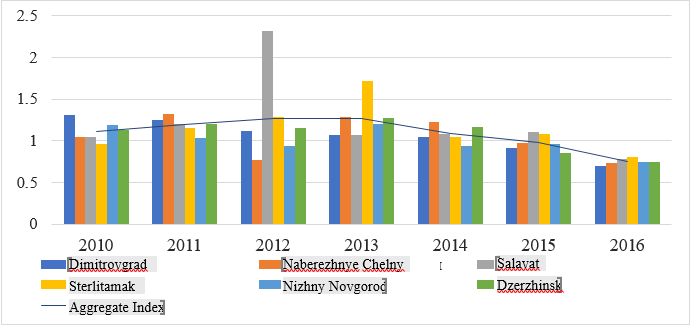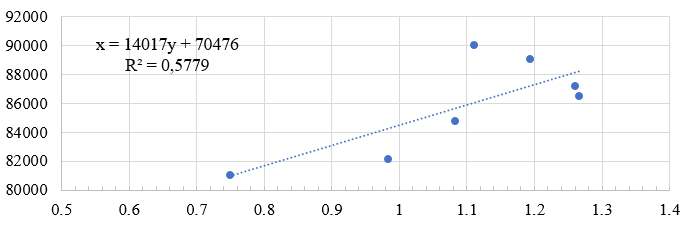Abstract
Clusters are becoming increasingly important in regional and urban innovative development. The paper analyzes the impact of energy clusters on socio-economic development of cities that are the ground for their functioning. Four energy clusters specializing in oil refining and nuclear energy and located in the Volga Federal District were selected for analysis. During the study, the average urban development rate was calculated based on the indicators characterizing their socio-economic performance. An econometric model was constructed, reflecting the effect of enterprises operating within the target clusters on socio-economic indicators of urban development. During the analysis, it was determined that an increased average number of staff employed in those industries where the target clusters are involved has a positive effect on urban development. However, there are risks related to narrow production specialization, which can negatively affect the economy of cities during off-peak times in a particular industry. The authors also actuate a problem associated with the efficient use of budgeting allocated for scientific and experimental products that are to be developed under the projects for the development of these clusters. Along with these sources of financing, it is necessary to attract more venture capital investments in research projects implemented on the basis of clusters. The authors also come to the conclusion that there is a threat of monopolization of energy markets due to rent-oriented behavior of stakeholders, which indicates the need for modernization of cluster policy in order to avoid the socio-economic decline of municipalities.
Keywords: Clustersenergy clustersurban development
Introduction
At the present stage of economic development, it is crucial to incorporate advanced scientific and technological innovations into the production cycle. Unlike large enterprises that can afford to run their own research centers, small and medium-sized businesses cannot, and therefore the risks of unsuccessful use of certain innovations increase sharply. Hence, the problem mostly features scalability, which no longer allows small and medium-sized businesses to solve it on their own. It is at this stage that the state enters an organizational hierarchy of any cluster, which acts as a regulatory and supervisory institution. Thus, clusters have become a tool for solving emerging challenges, i.e. advancing innovative development, upgrading the level of competitiveness of both enterprises and the economy of the region as a whole, and improving the quality of people’s life of the territories engaged in the cluster.
Problem Statement
The paper analyzes and evaluates the impact of energy clusters on socio-economic development of cities that are the ground for their functioning. The issue is relevant due to the evolving role of clusters viewed as tools to nourish innovative and technological development of enterprises.
Research Questions
World practice indicates that in the past two decades, the process of cluster formation has been quite vivid. According to experts, to date, clustering generally covers about 50 % of the economies of the leading countries worldwide. In addition to classical works in this area (Bresnahan et al., 2001; Harford, 2005; Porter, 1998), there are some new approaches to the goals and tools required for the formation and development of the cluster. For example, the Competitive Clusters program, implemented in France, was successful thanks to the solid state financial support (about 1.5 billion euros). A total of 71 clusters were involved, with groups of clusters to be identified in line with the scale and priority areas of production: global competitiveness clusters, globally-oriented competitiveness clusters and competitiveness clusters. With this rating in view, financing was allocated in the ratio of 50 %-25 %-25 % (Karine et al., 2011).
Some authors believe that clusters perform a foreign economic function and affect both the export policy of states and the internal regional and urban development (Rodnyansky et al., 2016; Rodnyansky et al., 2017). There is another point of view that clusters are independent entities, and their development, similar to that of enterprises, depends on a stage of cluster life cycles (Menzel & Fornahl, 2009). Other authors believe that thanks to clusters, a new “smart” economy is created, and the clusters themselves contribute to the development of a knowledge and innovation economy (Audretsch & Feldman, 1996; Carlsson et al., 2002; Tallman et al., 2004).
Purpose of the Study
The study aims to assess the effect of energy clusters on the socio-economic development of cities that are the ground for their establishnment.
Research Methods
The study examined four energy clusters located in the Volga Federal District (Table
A time series (Aggregate Index, hereinafter – Y) was selected as the dependent variable for the construction of the regression equation. It reflects average socio-economic rates of urban development from 2010 to 2016, calculated on the basis of the following parameters (Figure
Municipal expenses for:
Housing and utilities;
Education;
Social policy;
Physical education and sport;
National issues;
Population;
Investments in fixed assets;
Average annual staff of organizations;
Number of registered unemployed citizens;
Number of enterprises and organizations.

The following indicators were used as independent variables, which, in the authors’ opinion, are most accurately able to reflect the features of cluster functioning (Table
In order to determine the relationship between the variables and exclude indemendent variables that have multicollinearity, a correlation matrix is constructed (Table
Findings
Following the analysis of the data, it is possible to determine which of the independent variables have the greatest relationship with Y. It is obvious that Y has the strongest relationship with the variable X1, while the multiple R of all other variables turns out to be below the strong connection boundary. This suggests that there is no multicollinearity between independent variables. Hence, it is necessary to construct a paired regression equation with the parameter X1:
For ease of perception, the variables are interchanged in the equation. This is shown in the graph in which the abscissa axis (0X) is vertical and the ordinate axis (0Y) is horizontal. Pointedly, the meaning of the dependence does not change (Figure

The economic meaning of the graph is that with an increased average number of staff employed by organizations in the above areas by 1000 people, the annual rate of socio-economic development increases by about 0.0713 points or more than 7 %. Thus, the greatest effect on the development of cities with energy clusters is provided by the level of efficient and productive involvement of manufacturing industry, production and distribution of gas and water, construction, etc. in terms of employability.
Thus, the overall picture of the above analysis results will have the following form (Table
Conclusion
The calculations showed the intensity each of the energy clusters affects the socio-economic urban development. The dynamics of socio-economic indicators, which were included in the final index, often had similar behavior among all the selected cities, despite the fact that these municipalities are located in different regions. Given the fact that socio-economic development showed, on the whole, a downward trend, this allows the authors to conclude that the formed cluster structures are able to most effectively influence urban development only during periods of economic recovery. Moreover, in case of crisis situations, such urban development terminates, and therefore there is a migration outflow of the population to more promising regions. This implies the main positive and negative factor in the formation of clusters – their narrow specialization in a particular type of activity, which, depending on external influences, can both increase the attractiveness of cities and reduce it. In this regard, in order to minimize the negative impacts of this “failure”, it is necessary to form a competent cluster policy both at the federal, regional, and local levels.
References
- Audretsch, D., & Feldman, M. (1996). Innovative clusters and the industry life cycle. Rev. of Industr. Organizat., 11(2), 253–273.
- Bresnahan, T., Gambardella, A., & Saxenian, A. (2001). 'Old economy' inputs for 'new economy' outcomes: Cluster formation in the New Silicon Valley. Industr. and Corpor. Change, 10(4), 835–860.
- Carlsson, B., Jacobsson, S., Holmen, M., & Rickne, A. (2002). Innovation systems: Analytical and methodological issues. Res. Policy, 31(2), 233–245.
- Harford, J. (2005). What drives merger waves? J. of financial econ., 77(3), 529–560.
- Karine, D., Nejla, B., Fanny, F., & Sylvain, A. (2011). Agri-Food Clusters: Is French Policy in Line with Real Spatial Dynamics? In Special Session of AESJ2011. Tokyo.
- Menzel, M., & Fornahl, D. (2009). Cluster life cycles-dimensions and rationales of cluster evolution. Industr. and Corporate Change, 19(1), 205–238.
- Porter, M.E. (1998). Clusters and the new economics of competition, Harvard busin. Rev., 76(6), 77–90.
- Rodnyansky, D., Yasnitskaya, Y., & Koryakina, T. (2017). Assessment of cluster policy implementation effectiveness in the Russian regions, Revista publicando, 4(13), 502–514.
- Rodnyansky, D., Yasnitskaya, Y., & Polyakova, O. (2016). Energy clusters and their value in export policy. Sgem 2016, bk 2: political sciences, law, finance, economics and tourism, III, 205–211.
- Tallman, S., Jenkins, M., Henry, N., & Pinch, S. (2004). Knowledge, clusters, and competitive advantage. Acad. of Managem. Rev., 29(2), 258–271.
Copyright information

This work is licensed under a Creative Commons Attribution-NonCommercial-NoDerivatives 4.0 International License.
About this article
Publication Date
31 October 2020
Article Doi
eBook ISBN
978-1-80296-091-4
Publisher
European Publisher
Volume
92
Print ISBN (optional)
-
Edition Number
1st Edition
Pages
1-3929
Subjects
Sociolinguistics, linguistics, semantics, discourse analysis, translation, interpretation
Cite this article as:
Razdobarova, M. N., Ivanova, L. M., Kalinichenko, E. B., & Lanina, A. (2020). Information Technologies In The Process Of Formation Of Intercultural Communicative Competence. In D. K. Bataev (Ed.), Social and Cultural Transformations in the Context of Modern Globalism» Dedicated to the 80th Anniversary of Turkayev Hassan Vakhitovich, vol 92. European Proceedings of Social and Behavioural Sciences (pp. 2313-2320). European Publisher. https://doi.org/10.15405/epsbs.2020.10.05.305

